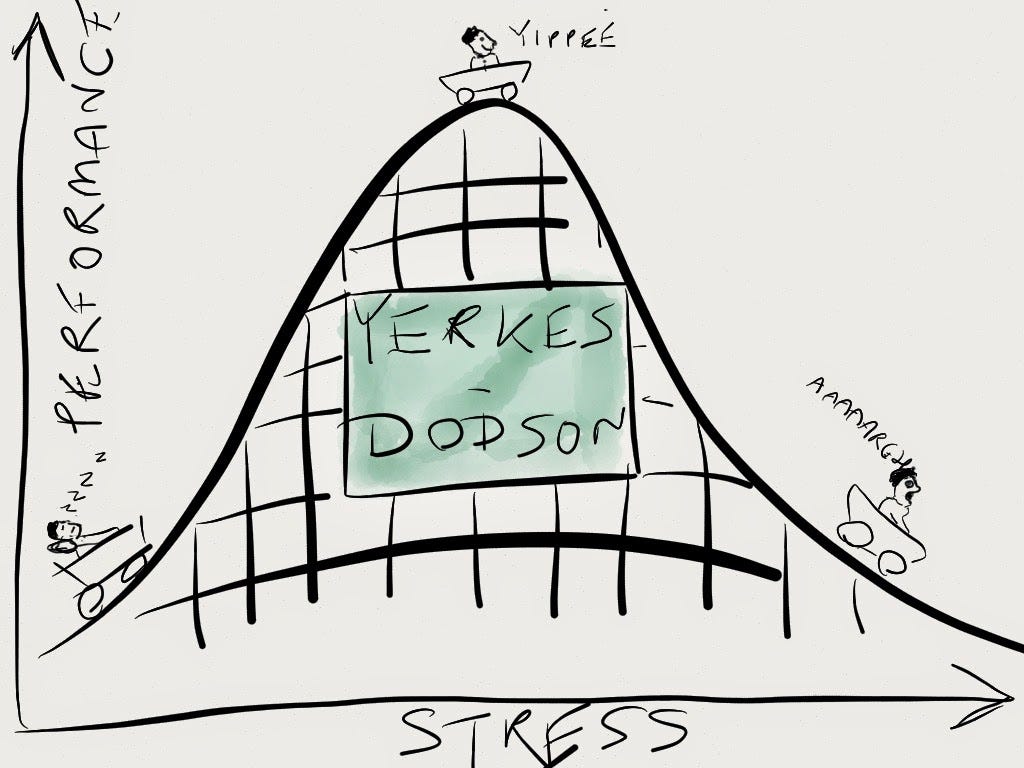Your cart is currently empty!
The Tipping Point of Burnout vs. Self Care
By
.

It happens to the best of us. Sometimes its a sneaky gremlin surprising us in the night, and other times it hits us like a bus zooming along a downtown avenue, full of business people who clearly have their shit together. Regardless, it hits us. We teeter over an invisible arête thin tipping point and free fall into catastrophic burnout at worst or a bad head cold. At best, we slump exhausted onto the couch, desperate for a Netflix binge session to wipe the slate clean.
And yet, I keep careening past that tipping point. I just seem to sign up for more. I can’t help myself. I need to do all of the things, all of the time.
And it’s bizarrely fascinating.
My Over Functioning Lizard Brain
Getting shit done is what gets me out of bed in the morning. And I love it. Even on the weekends I find it hard to sit still and not have a game plan of action items that must be demolished, checking items of a mental list for constant gratification. And I’m constantly complimented on how much I am able to accomplish in a day. Great right? Most of the time.
And then I say “yes” to more things, or raise my hand, or jump in when I see something not getting done. Most of time—truly—this fuels me, brings me excitement and gets me out of bed in the morning. But sometimes it just royally pisses me off. And I’ve started to question why I feel the intense need to raise my hand, to say a wholehearted yes, to lean in to doing anything that in the moment brings me joy.
Why do I feel the need to do all of the freaking things?
In times of high stress or crisis I go into serious action mode. Nay, I thrive. My emotional lizard brain goes on lock down, I become numb, and I seriously GSD. And I have a really hard time coming down from the times of stress. In fact, I think I’ve become accustomed to functioning at a more constant slightly frantic place to where anything less feels like standing still, which in turn drives me slightly crazy. And yet the burnout associated with over functioning over time still sneaks up on me.
Lately, I’ve found myself feeling burnt out and frustrated by my surroundings, wondering why no one will step up to help me, even when I feel like I’m screaming for help at the top of my lungs. And then I realize that no sound is escaping in those screams. I rarely even actually whisper the words “I. Need. Help.”
“Over-functioners truly believe they are doing everything possible to be helpful to fix the situation They can see other people as either unwilling or unable to “shape up” to their standard. Rather than feel vulnerable they go into action mode. Unfortunately those around them may reinforce this attitude by under-functioning and just letting them get on with it.
Under-functioners, by contrast, in the face of an anxious situation, get caught up in their feelings and start showing up less, don’t get stuff done and get less competent. They especially slip back in the face of the over-functioners who are stepping in and vacuuming up all the jobs.”
— Karyn Prentice, The Coaching Supervisory Academy
A commonly suggested solution I discovered as I read the depths of the internet on this subject (originally popularized by Harriet Lerner) was to have a couple trusted people around you who can call you out on over-functioning. Not by pointing out the immediate behavior of being the first to offer solutions, micro-managing or saying yes to too many things others could do themselves, but by saying “hey, watch out for your over-functioning lizard brain.” The over and under functioning way of being is an ingrained reaction and response to external or internal stressors. A difficult thing to change as it’s more deeply ingrained than habit. I’m really just grasping how this behavior plays out in every aspect of my life, from work-work to volunteer-work to co-parenting and even new romantic relationships. Especially since both over and under functioning are used as methods to run away from vulnerability and not address your own emotional needs. Ugh. Deep shit.
“For overfunctioners,” says Brené Brown, “it’s easier to do than to feel.”
Double Ugh. Quit it Brené. She also has stated that over-functioning is more common in first born girls. Nailed it.
some Stress is Good, and Relative
How we all function as our best selves ebbs and flows situationally and in context of internal and external stressors. The Yerkes-Dodson law examines the relationship between stress stimuli and performance, with performance increasing to a peak with the “right” amount of stress, then declining into burnout (and even death in some renditions).

Just the right amount of stress stimuli causes us to function at an optimal performance, in a super charged get-all-the-things-done mode. And not all stress is distinctly bad. Even my ritualistic medium-skinny-hazelnut-latte-with-an-extra-shot in the morning is adding in an external stimulant and purposefully pushing me up the left side of the curve. Too little interest and we are not engaged, too much and we tip into anxiety and later, crash into burnout. In addition, even the optimal amount of stress for an individual at the same levels over an extended period of time becomes enough to tip over the hill into the danger zone.
Whilst the shape of the Human Function Curve is the same for everyone, each individual has his or her own limits for coping with stressors (the ‘hump’). Different people respond to the same stressor in different ways, and not everyone will be stressed by the same things. It is not the stressor that makes people stressed, but their response to it, and that is a highly personal thing.
— Sue Paterson, The Fear Free Organization
The danger zone is utter messy burnout. We’ve all been there in different ways, some small and some large. There is a connection between emotional stress and your immune system too – so in moments on the downhill side of the curve, your body sucker punches you with that cold, cos it just can’t do it all. It wants you to take a freaking nap.
Stretching Yourself
Athletes use a similar curve in regards to increasing their body’s physical performance, and improving it’s abilities over time. By training and stretching beyond their comfort zone they can make their bodies able to do more, go farther, and increase stamina.
I would hypothesize that we can do the same thing with finding our optimal stress and burnout tipping point. By continuously stretching ourselves, we increase our capacity to handle anything — from larger projects at work, to unfamiliar situations, to heavier workloads. Maybe I’m an athlete in getting-shit-done and that’s why I find myself functioning in the relative extreme for extended periods. Let me know when it’s an Olympic sport.
Another note on the curve — tasks that may have been stressful the first time, but become easier through practice have less impact on your stress levels, therefore cannot be used to keep yourself at an optimal level. So if you’re a bit like me (I can’t be the only one… right?) then you seek a bit of that top of the curve thrill on the precipice by pushing yourself to learn new things constantly. The learning curve is challenging and enticing.
The connection here to preventing further catastrophic burnouts however, is a moment of self awareness to optimize stress levels and be continuously stretching oneself without tipping too far down the yerkes/dodson bell curve. We can learn by recognizing when we feel too much overly negative anxiety. For me I am learning that when my inner martyr-gremlin really starts to speak up, and I start noticing the over/under-functioner relationships in my life through a negative lens that’s when I really need to cool it. When that starts to happen I also chronically lose sleep over worrying about people and things, and also start feeling run down and exhausted. Netflix and actually chill time.
“to master stress, you must change. You have to figure out what you are doing that is contributing to your problem and change it. These changes fall into four categories: change your behavior, change your thinking, change your lifestyle choices and/or change the situations you are in. By getting to the root causes of your stress, you can not only relieve current problems and symptoms but you can also prevent recurrences.”
—Beth of Not To Be Trusted With Knives
Leaning in to Recovery Time
Another thing that athletes do is build in recovery time. Even throughout our own mini-marathon workdays, we can be aware of things like Ultradian rhythms, where our peak performance and concentration can at most last 90 minutes before needing a 20 minute reset time. Taking a quick walk, a moment of deep, meditative breathing and changing your scenery help you maximize your productive energy.
In Lean In, the Lean the Fuck Out I explored the process of sprinting and then recovering. I’ve been experimenting with the process, sometimes through failure (aka burnout) and sometimes through iteration and launching an MVP Podcast in 2016. I’m realizing that I also need to embrace built in recovery time, which shouldn’t be rocket science, but it seems to be a lesson I need to keep learning.
Other ways to decrease unwanted stressors are not a surprise; decreased or eliminated Caffeine intake (I’ll buy you all a coffee if that ever happens on my end), regular exercise, more sleep and relaxation time help keep us on the non-burnout side of the curve. It’s a balancing act constantly.
Finding ways to be kind to yourself, and recognizing your own burnout triggers will help you optimize your own stress and performance curve, and perhaps even stretch yourself to be higher—or lower—functioning. In the All the Things podcast, I explored the topic of burnout and self-care with many viewpoints which brought me a sense of self realization and awareness that I need to change something up.
As with many things, the first step is admitting you have a problem.
Hello World, I am an over-functioner.

Leave a Reply